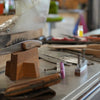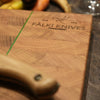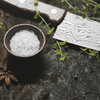Everything you need to know about steel for knife blades

Steel is the heart of every high-quality knife. But what does carbon steel, tool steel, carbon steel, etc. mean? This article gives you an insight into the world of knife steels and explains the differences between stainless and non-stainless steels.
1. Not stainless or stainless: The difference
Steel for knife blades consists essentially of iron and a certain amount of carbon. In its purest form, it contains about 0.6 - 1.4% carbon. This carbon content influences the sharpness and hardness of the steel. In its pure form, the steel is very hard and sharp, but also brittle. To achieve the perfect balance between hardness and flexibility, the steel is tempered at a low temperature. This results in a hardness of about 60-63 HRC.
Carbon steel, also known as high carbon steel, has been used for centuries to make high-quality blades. Famous examples include Japanese katana swords and razors. These steels are known by names such as tamahagane.
Compared to stainless steels, carbon steel knife blades offer impressive sharpness and edge retention. However, the blades require special care as they are susceptible to rust and acid. However, the grey patina that forms on the blade serves as a natural rust protection. If the knife is to be stored for a long time or in high humidity, it is advisable to use food-safe blade oil.
2. Stainless vs. Rust-resistant: The meaning of "not stainless"
The term "stainless" is actually misleading, as no steel is truly rust-free. The correct term should be "rust-resistant". Stainless steel contains at least 13% chromium to protect it against acids and moisture. This is particularly useful for knives that come into contact with fruit acid or salt water, such as outdoor knives, fruit knives or diving knives.
Chromium forms relatively large carbides in steel, which stabilize the cutting edge. Stainless steels are generally more stable, even if they cannot keep up with carbon steels in terms of sharpness.
3. Quality differences in Damascus steel
Damascus steel is an impressive work of craftsmanship. It combines different steels into a unique alloy that can be customized depending on the application. However, it is important to note that the term "Damascus steel" is often misused. Industrial Damascus, produced in large rolling mills, is very different from hand-forged Damascus.
Hand-forged Damascus requires a lot of experience and precision. It is made of at least two types of steel that have different properties. This allows for an optimal balance between hardness, sharpness and flexibility. A high-quality Damascus is evaluated according to various criteria, including the selection of steels, the arrangement of the layers and the quality of the forging work.
4. The Mysterious Damascus Steel
Damascus steel is a fascinating material that has captured the imagination of knife collectors and connoisseurs for centuries. It is characterized by its characteristic wave pattern, which is created by repeatedly folding and forging two or more different types of steel. This complex process requires skill and experience to achieve the desired properties in the Damascus.
The choice of steels used in Damascus is crucial. A good Damascus combines steels with different properties, such as hardness and toughness. This combination makes it possible to produce a blade that is not only extremely sharp, but also resistant to breakage and deformation.
5. Quality makes the difference
There are considerable differences in the quality of Damascus steel. A high-quality Damascus steel meets certain criteria:
-
The steels in Damascus are tailored to the intended use : A high-quality Damascus should consist of steels that complement each other in their properties and meet the requirements of the knife. Cheap Damascus steels often use inferior components, which leads to poor performance.
-
The arrangement of the steels in the Damascus is well thought out : the layers in the Damascus should be arranged in such a way that they support the desired properties in the knife. The number of layers in the Damascus also influences the pattern.
-
The heat treatment is precise : Since the production of Damascus steel heats the steel to extreme temperatures, precise heat treatment is required. This ensures that the steel structure is refined again and the blade stays sharp for a long time.
-
Weld defects are minimal : Small weld defects may occur, but should be minimal and should not affect the overall performance of the blade. Large defects should not be easily repaired with the welder, as these areas will not harden sufficiently.
-
Experienced Damascus steelsmiths carry out the hardening and tempering : The hardening and tempering of the finished blade requires expertise and experience to achieve optimal results. Only an experienced Damascus steelsmith can exploit the full potential of the material.
In conclusion, the world of knife steel is fascinating and complex. Choosing the right steel depends on your individual needs and preferences. Whether you choose carbon steel, stainless steel or hand-forged Damascus, quality and craftsmanship are crucial to the performance and longevity of your knife.





